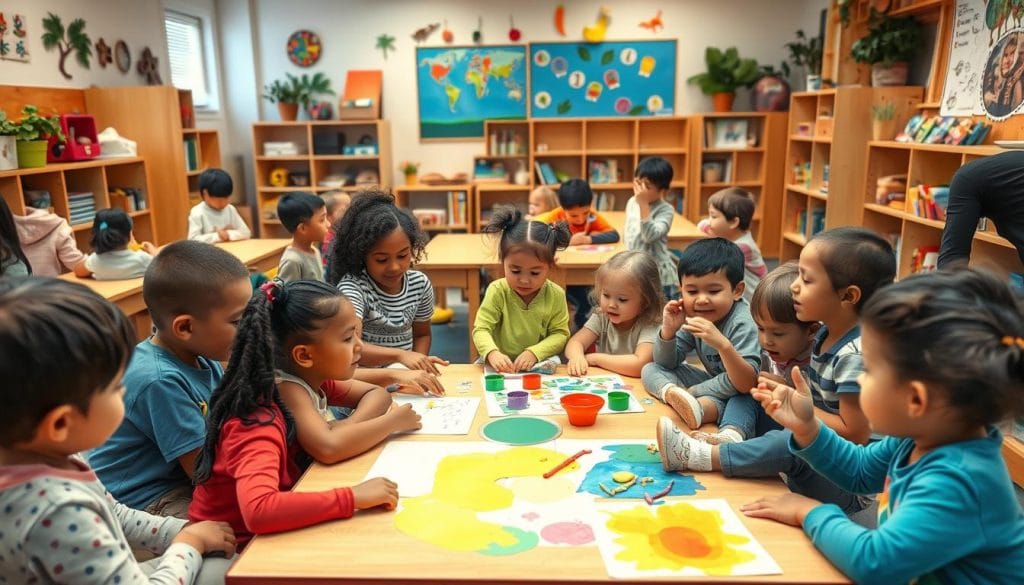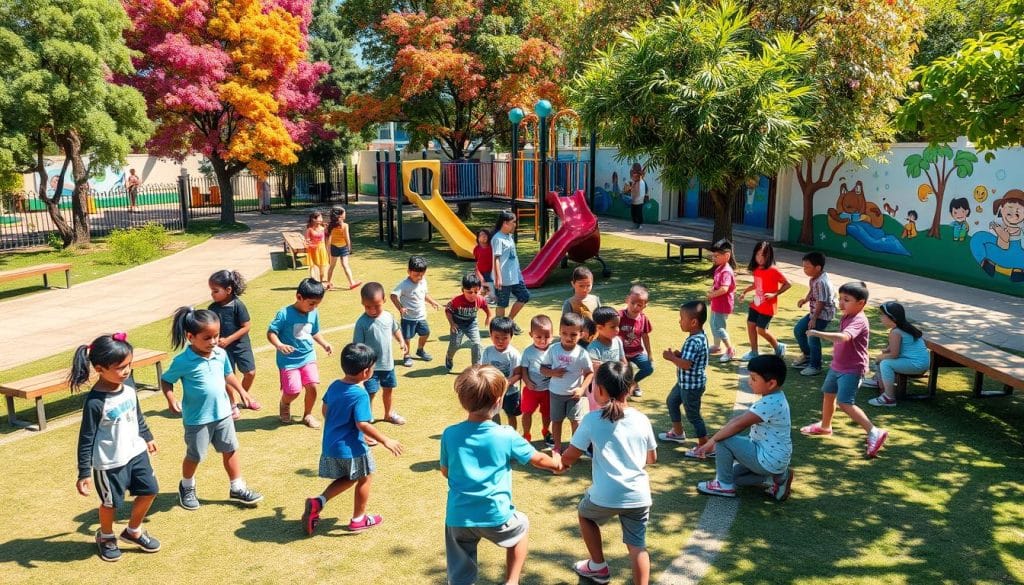The sun shone brightly in the classroom, lighting up the faces of eager young students. It was the first day of school, and the teachers had worked hard to make sure every child felt welcome. They wanted everyone to feel valued, no matter their background or abilities.
In today’s world, creating an inclusive classroom is more important than ever. Inclusive education is about more than just meeting different needs. It’s about making every child feel like they belong, helping them grow, and building a community of respect and understanding.
The teachers knew this was a chance to make a big difference. By focusing on diversity and inclusion, they were setting the stage for a future where everyone’s differences are celebrated. They wanted every child to be proud of who they are.
Key Takeaways
- Inclusive education is essential for creating a welcoming environment for all children.
- Fostering diversity and inclusion in learning spaces empowers children to reach their full potential.
- Embracing differences and celebrating each child’s uniqueness lays the foundation for a more inclusive future.
- Accommodating various needs and backgrounds is crucial for cultivating a sense of belonging.
- Promoting mutual respect and understanding among children is a key aspect of creating a welcoming environment.
Understanding the Importance of Inclusivity
In early education, creating an inclusive environment is key for kids’ growth. It meets diverse needs and values cultural differences. Culturally responsive teaching helps make equitable learning spaces. These spaces foster empathy, celebrate diversity, and build a fair society.
The Benefits of Inclusivity in Early Education
Inclusive learning environments offer many benefits. They help kids grow socially and emotionally. They also boost their thinking skills and make them feel part of a community.
By valuing diversity and individual strengths, teachers help kids become confident and caring. They become active learners.
Fostering Empathy Among Children
Inclusivity helps kids develop empathy. This skill lets them see things from others’ viewpoints. Through cultural activities, kids learn to value differences and grow compassionate.
Encouraging Diversity in Learning Environments
- Incorporate diverse representation in curricular materials, classroom decor, and learning resources.
- Encourage children to share their unique cultural traditions and experiences.
- Facilitate discussions that challenge stereotypes and promote respect for individual differences.
- Collaborate with families to incorporate culturally relevant practices and perspectives into the learning environment.
By making learning spaces inclusive, teachers help kids value diversity. They become culturally aware and ready to make a difference in their communities.
Key Principles of a Welcoming Environment
To make a learning space welcoming for all, we need to think carefully about several things. We must focus on making it accessible and showing respect for different cultures.
Accessibility for All Children
It’s very important to make sure everyone can join in. This means using tools that help, making physical spaces work for everyone, and having learning materials in many ways. When we remove obstacles, all children can learn and grow together.
Respecting Different Cultures and Traditions
Acceptance and belonging start with valuing each child’s culture. We can do this by using an anti-bias curriculum that celebrates diversity. This curriculum helps kids understand and appreciate different cultures, teaching them important social-emotional learning skills.
- Use books, toys, and art that show the community’s diversity.
- Let kids share their cultural stories and traditions.
- Work with families to include their cultural practices in the classroom.
By focusing on accessibility and cultural respect, teachers can make a place where every child feels important, accepted, and ready to succeed.
| Principle | Importance | Key Strategies |
|---|---|---|
| Accessibility | Ensures all children can actively participate and engage |
|
| Cultural Respect | Cultivates a sense of belonging and acceptance |
|
“Creating an environment where all children feel welcomed, valued, and empowered is the foundation for their academic, social, and emotional growth.”
Physical Space Considerations
Creating a welcoming space for kids is more than just making them feel included. It also means paying attention to the physical areas where they learn and play. By designing spaces that are fair for everyone, we help every child succeed.
Designing Inclusive Play Areas
Playgrounds are key in early childhood education. To make them inclusive, add different play equipment and surfaces for all kids. Include sensory-rich elements, wheelchair-accessible structures, and low-impact play that encourages teamwork and creativity.
Safety Measures for All Ages
Keeping kids safe is crucial. Use age-appropriate safety features like secure fencing, soft flooring, and shatterproof windows. Also, add visual aids and signage to help kids move around safely and on their own.
| Inclusive Play Area Features | Safety Measures for All Ages |
|---|---|
|
|
By designing inclusive play areas and adding safety features for all ages, we can make early childhood education centers welcoming. This supports the growth and development of every child.
Social and Emotional Support
Creating a welcoming space for all children is more than just making things accessible. It’s also about focusing on their social and emotional needs. This means building positive relationships and encouraging open communication. By doing this, early education settings help every child feel valued and empowered to succeed.
Building Positive Relationships
At the core of an inclusive environment are the connections between children, teachers, and staff. Activities that build these relationships teach kids about empathy, teamwork, and respect. Teachers can show these values by playing together, sharing feelings, and celebrating each other’s strengths.
Promoting Open Communication
Good communication is key for supporting kids’ social-emotional learning and helping with trauma-informed practices. Teachers should make sure kids have safe ways to express themselves. This can be through talking, gestures, or other means. Regular talks help kids share their thoughts and feelings, building trust and a sense of belonging.
“When children feel heard and understood, they are more likely to develop the resilience and self-awareness needed to navigate challenging situations.”
By focusing on social and emotional support, early education settings help children grow in many ways. They learn to connect with others, manage their feelings, and gain important skills for the future.

Involving Families in the Process
Creating a welcoming space for kids needs strong partnerships between schools and families. By working together, schools can build a community. They can also make sure each child’s needs and culture are respected and celebrated.
Engaging Parents and Guardians
Good family engagement starts with open talks and a real interest in parents’ views. Schools should find many ways for families to get involved in their child’s learning. This includes:
- Regular parent-teacher meetings
- Inviting parents to help in the classroom or on trips
- Letting parents share thoughts on school rules and ways of teaching
- Hosting family events and workshops
Culturally Relevant Events
It’s key for schools to celebrate the community’s cultural diversity. They can show they care about culturally responsive teaching by planning events that honor different traditions. This could be:
- International food fairs or cultural festivals
- Shows and performances that highlight students’ talents
- Workshops on traditional crafts, dance, or stories
- Talks on why diversity matters in schools
By involving families, schools can strengthen bonds, make everyone feel at home, and help kids feel proud of who they are.
Training and Professional Development
To make schools welcoming for all, teachers need ongoing training. They must learn about inclusivity and diversity. This ensures they can create a welcoming space for everyone.
Workshops on Inclusivity
Workshops on inclusive education are key. They help teachers understand and apply diversity and inclusivity. Topics include cultural sensitivity and supporting students with special needs.
- Engaging in interactive activities and role-playing exercises to practice inclusive strategies
- Learning about the latest research and best practices in inclusive education
- Networking with other educators to share experiences and learn from one another
Strategies for Educators
Teachers are vital in building an inclusive school culture. They can make sure all students feel valued and respected. This lets everyone participate fully in learning.
- Fostering open communication and encouraging children to share their perspectives
- Adapting teaching materials and methods to cater to diverse learning styles and needs
- Promoting collaborative learning activities that celebrate diversity and teamwork
- Recognizing and celebrating the achievements and contributions of all students
By focusing on professional growth, schools can become truly inclusive. This supports the success of all students.
| Inclusive Education Strategies | Benefits |
|---|---|
| Providing diversity and inclusion training for staff | Enhances cultural awareness and sensitivity |
| Offering accessible learning materials and resources | Ensures all students can actively participate |
| Implementing collaborative learning activities | Fosters teamwork, communication, and empathy |
| Recognizing and celebrating individual achievements | Boosts self-confidence and a sense of belonging |
“Inclusive education is not just about access, but about ensuring that every child can participate, learn, and grow in a safe and supportive environment.”
Tailoring Activities for Diverse Needs
Creating an equitable learning environment means catering to the diverse needs of all children. By adapting educational materials and designing inclusive group activities, educators can foster a sense of belonging and promote team-building skills among students.
Adapting Educational Materials
To ensure an anti-bias curriculum, educators should regularly review and modify teaching resources. This ensures they better reflect the backgrounds and experiences of the children in their care. It may involve incorporating more diverse narratives, adjusting the reading level of materials, or providing alternative formats, such as audiobooks or visual aids, to cater to different learning styles.
Group Activities for Team Building
- Cooperative learning exercises that encourage collaboration and problem-solving
- Structured group discussions that allow children to share their perspectives and learn from one another
- Team-building games and icebreakers that promote social interaction and bond-building
By engaging children in inclusive group activities, educators can help foster a sense of community. This builds empathy and celebrates the diverse strengths and experiences each child brings to the learning environment.
| Inclusive Activity | Description | Benefits |
|---|---|---|
| Collaborative Art Project | Children work together to create a mural or collage, contributing their unique artistic talents and perspectives. | Promotes teamwork, communication, and appreciation for diversity. |
| Multicultural Storytelling Circle | Children take turns sharing folktales, myths, or personal narratives that reflect their cultural heritage. | Fosters cross-cultural understanding, empathy, and a sense of inclusion. |
| Inclusive Scavenger Hunt | Children work in teams to find items that represent diverse identities, interests, and abilities. | Encourages exploration, problem-solving, and recognition of individual differences. |
By tailoring activities and materials to meet the diverse needs of children, educators can create more equitable learning spaces. These spaces celebrate the unique qualities of each individual and foster a stronger sense of community.
Encouraging Positive Behavior
In inclusive early education, it’s key to foster positive behavior. This creates a welcoming and supportive community. By using effective conflict resolution and recognizing each child’s strengths, educators can build a place that values diversity. This encourages social-emotional learning.
Conflict Resolution Techniques
Teaching kids to handle conflicts well is vital for a positive classroom. Educators can teach them to listen actively, build empathy, and solve problems together. These skills help kids resolve disputes peacefully and grow their interpersonal abilities.
Recognizing and Celebrating Differences
An inclusive space thrives when kids feel valued for who they are. Teachers can plan activities that showcase the diverse backgrounds, talents, and views in the classroom. By celebrating these differences, kids learn to see the value of community in their education.
| Strategies for Promoting Positive Behavior | Benefits |
|---|---|
|
|

“When we learn to celebrate our differences, we discover the true power of our community.”
Assessment of Environment Effectiveness
Creating a welcoming space for all kids is a never-ending task. It needs constant checking and making things better. It’s key to get feedback from staff and families to see if what we’re doing works.
Gathering Feedback from Staff and Families
Getting input from those who work with kids can give us great insights. It helps us see what’s working and what needs work. Also, talking to families about how we’re doing can show us what we’re missing.
- Conduct anonymous surveys to gather honest feedback from staff and families
- Organize focus groups or interviews to dive deeper into specific concerns or successes
- Encourage open communication and create channels for continuous feedback
Making Necessary Adjustments
After hearing from staff and families, we can see where we can do better. This might mean changing the classroom, updating rules, or training teachers. It’s all about making sure everyone feels included and supported.
“Continuously improving the learning environment to be more inclusive and responsive to the needs of all children and families is the key to ensuring a truly welcoming and supportive educational experience.”
Being open to change shows we care about making a welcoming place for all. It shows we’re ready to grow and meet the changing needs of our community.
Utilizing Technology for Inclusion
Technology has changed how we teach in today’s world. It helps make learning spaces fair for everyone. This part talks about how tech can make learning better for young kids.
Digital Tools for Communication
Good communication is key in inclusive education. Tools like video calls, messaging apps, and virtual whiteboards help a lot. They make it easy for teachers, kids, and families to talk and share ideas.
Learning Apps for Diverse Needs
There are many learning apps now that help kids with different needs. These apps have special features and ways to learn that everyone can enjoy. They make learning fun and help kids feel good about themselves.
| Digital Tool | Key Features | Inclusive Benefits |
|---|---|---|
| Zoom |
|
|
| Seesaw |
|
|
Using technology wisely in teaching can make learning better for everyone. It makes learning fun, fair, and helps kids grow.
Community Partnerships
Creating a welcoming space for kids needs teamwork that goes beyond school walls. Early education teams can get help from community partners. This boosts learning for kids.
Collaborating with Local Organizations
Working with local groups can make schools more welcoming. These partnerships offer special services like language help and cultural events. This way, schools can meet the needs of all kids.
Hosting Inclusive Community Events
Hosting events that welcome everyone helps kids feel part of a community. These events let kids celebrate their differences and find common interests. They can be cultural festivals or family activities.
Putting community first has a big impact on schools. By using community resources and building partnerships, schools can be places where diversity is celebrated. This helps all kids grow and succeed.
| Benefits of Community Partnerships | Strategies for Hosting Inclusive Events |
|---|---|
|
|
“When we build connections with our local community, we create a stronger, more vibrant learning environment for all children.”
Future Trends in Inclusive Education
Education is changing fast, bringing new ways to welcome all kinds of students. We’re seeing better technology and social changes that help everyone learn together. This makes inclusive education exciting and full of promise.
Innovations in Welcoming Environments
New tech is changing how we design schools. Imagine classrooms with smart furniture and interactive boards. There are even voice assistants to help everyone learn.
Virtual and augmented reality are also coming into schools. They offer unique learning experiences. This helps students feel more connected and included.
Influence of Social Changes on Education
Our society is becoming more open to diversity and inclusion. This change is affecting how we teach. Schools are now teaching about different cultures and empowering students to be themselves.
This approach builds empathy and prepares students for a global world. It’s a big step towards a more inclusive future.
